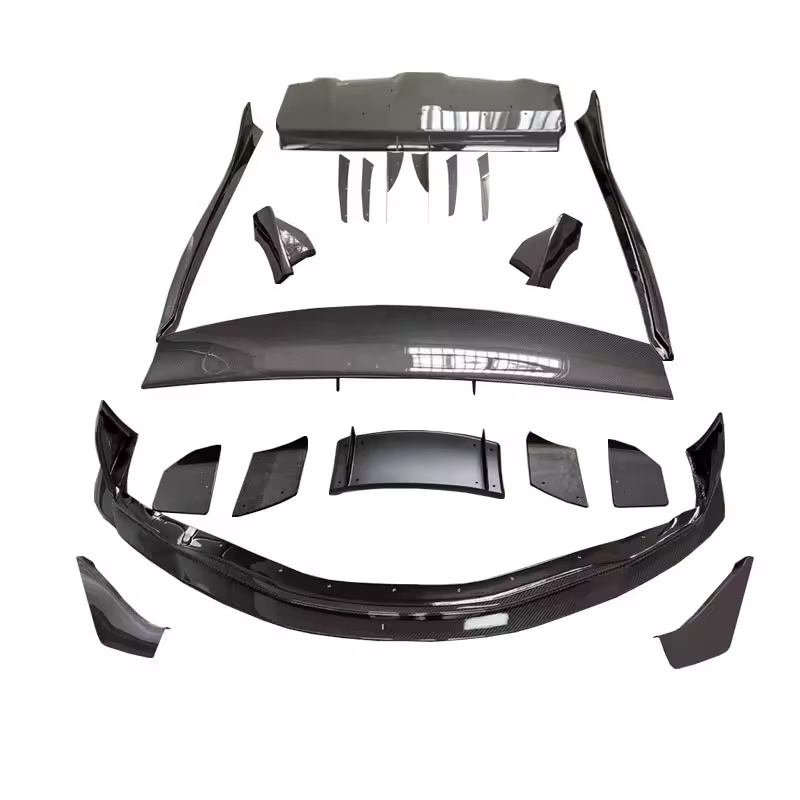Common Carbon Fiber Modification Errors and Solutions
2024
Introduction:
Carbon fiber modification has become increasingly popular among automotive enthusiasts seeking to enhance performance and aesthetics. However, certain common errors can arise during the modification process, leading to suboptimal results or even damage to the vehicle. This article aims to highlight these common errors, provide advice on avoiding modification pitfalls, and offer expert insights to address frequently asked questions from customers.
Common Errors in Carbon Fiber Modification:
●Improper Installation: One of the most common errors is improper installation of carbon fiber components. This includes incorrect fitting, inadequate use of adhesive, or failure to follow manufacturer guidelines. Improper installation can result in loose or misaligned parts, compromising both aesthetics and structural integrity.
●Overlooking Compatibility: Another frequent mistake is overlooking compatibility issues between carbon fiber parts and the vehicle's existing components. This can lead to compatibility issues with mounting points, electrical connections, or aerodynamic performance. Failure to address compatibility can result in functional limitations or even damage to the vehicle.
●Neglecting Quality Control: Some enthusiasts may opt for lower-quality carbon fiber components to save costs, overlooking the importance of quality control. Substandard materials may exhibit defects such as surface imperfections, resin pooling, or delamination, compromising both aesthetics and durability.
●Ignoring Weight Distribution: Carbon fiber modifications can affect the weight distribution of the vehicle, impacting handling and performance. Failing to consider the overall weight distribution when adding carbon fiber components can lead to handling imbalances, reduced cornering stability, or increased tire wear.
●Neglecting Structural Reinforcement: While carbon fiber is known for its strength and lightweight properties, it is essential to reinforce structural components adequately. Neglecting to reinforce critical areas such as mounting points or stress zones can lead to premature failure or safety hazards.

Avoiding Modification Missteps:
●Research Thoroughly: Before embarking on a carbon fiber modification project, conduct comprehensive research on the desired components, installation procedures, and compatibility with the vehicle. Consult reputable sources, forums, or professionals in the field to gather insights and recommendations.
●Invest in Quality: Prioritize quality over cost when selecting carbon fiber components. Invest in reputable brands known for their quality craftsmanship and rigorous quality control processes. While higher-quality components may come with a higher price tag, they offer superior fitment, durability, and aesthetics.
●Follow Manufacturer Guidelines: Adhere strictly to manufacturer guidelines and recommendations during the installation process. Follow proper installation procedures, use recommended adhesives and hardware, and ensure precise fitting to avoid potential issues down the line.
●Consider Professional Installation: For complex modifications or components requiring precise fitting, consider enlisting the services of experienced professionals. Professional installers have the expertise, tools, and experience to ensure proper installation and minimize the risk of errors or damage.

Expert Insights and Customer FAQs:
Q: Can carbon fiber components be painted or coated?
A: Yes, carbon fiber components can be painted or coated to match the vehicle's color scheme or add additional protection. However, it is essential to use automotive-grade paint or coatings suitable for use on composite materials and follow proper preparation and application techniques.
Q: Are carbon fiber components street legal?
A: In most cases, carbon fiber components are street legal as long as they comply with relevant regulations and do not compromise vehicle safety or emissions standards. It is advisable to verify legality with local authorities or consult with professionals familiar with automotive regulations.
Q: How can I maintain carbon fiber components?
A: To maintain carbon fiber components, regularly clean them with a mild detergent and water, avoiding harsh chemicals or abrasive cleaners. Apply a protective coating or wax to enhance durability and UV resistance, and inspect for any signs of damage or wear periodically.

 EN
EN
 AR
AR
 BG
BG
 HR
HR
 CS
CS
 DA
DA
 NL
NL
 FI
FI
 FR
FR
 DE
DE
 EL
EL
 HI
HI
 IT
IT
 JA
JA
 KO
KO
 NO
NO
 PL
PL
 PT
PT
 RO
RO
 RU
RU
 ES
ES
 SV
SV
 TL
TL
 ID
ID
 SR
SR
 SK
SK
 UK
UK
 VI
VI
 TH
TH
 TR
TR
 FA
FA
 AF
AF
 MS
MS
 GA
GA
 CY
CY
 IS
IS
 HY
HY
 AZ
AZ
 KA
KA
 MY
MY
 ONLINE
ONLINE